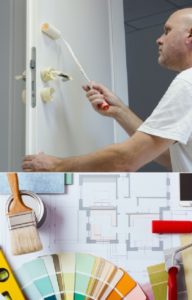Wood makes durable, long-lasting and beautiful architectural doors. It functions well in high-traffic settings like schools and hotels as well as upscale projects like high-end office buildings. The best part about choosing wood doors for a commercial design and construction project is the range of options. In fact, the number of choices available in wood veneers for interior doors can make it hard to decide. Here, we break down information on various species, cuts, stain colors, and other considerations so that you can specify interior wood doors with confidence.

1. Choosing a Species for Wood Veneer Doors
In general, wood doors, windows, molding and other touches add a sense of warmth and natural beauty to a space. However, the species and color of the wood can convey a variety of different styles. The look of wood varies significantly from one tree species to another and even within a species. Look for a color and texture that matches your design aesthetic.
Maple Doors
A classic choice, maple is strong, dense wood that makes doors built to last. Its smooth texture and light natural color respond well to paint or stain. It’s a good choice if you’re pursuing a traditional design aesthetic.

Birch Doors
Birch wood has a light-toned color not unlike maple. As such, it takes paint and stain colors well. It tends to feature a straight grain and uniform texture.

Cherry Doors
This medium-strength wood tends to last and resist warping. It’s a good idea to specify cherry wood interior doors away from sunlight since light can darken the wood over time. It’s sometimes associated with Shaker furniture or cabinetry, and it works well for high-end projects.

Oak Doors
Oak provides a classic look and lasts a long time. It resists water damage and cracking, so you can use it in spaces that take heavy use. The grain of white oak doors is symmetrical and pronounced without any significant knotting, which makes white oak suitable for both staining and painting. They’re great for craftsman and mid century design styles.

Mahogany Doors
The classic look of mahogany is ideal for executive offices or high-end hospitality projects. Its dark color is slightly more restrictive in terms of stain that can be used. Some clients may also raise concerns about its environmental impact.

2. Wood Doors and the Environment
Some clients selecting wood interior doors may express environmental concerns related to wood choice. For example, generally speaking, faster growing tree species are more sustainable than slower growing ones. Masonite Architectural is committed to environmental responsibility and reducing impacts by using wood fiber from well managed forests. We offer products, upon request, with wood certified by the Forest Stewardship Council® (FSC®) including 100% FSC and FSC Mix. In addition, our veneer lumber is certified Indoor Advantage Gold for indoor air quality.
FSC License Code: FSC-C005458”



3. Other Considerations for Wood Species
When you specify natural wood you might see variations in color from the same piece. Within a tree, the heartwood–closer to the center–is darker than sapwood. The difference is more dramatic in some species than others.
One of the attractive qualities about wood veneers is their unique natural surface character. They are far from uniform. Sometimes you may want a lot of variation across a project to achieve an eclectic feeling, but a manufacturer can work with you to select more closely matching samples.



4. Factory Staining Commercial Wood Doors
By combining the right wood species with the right factory stain, you can achieve exactly the look you want for architectural wood interior doors. Stain provides an added layer of protection as well as a polished appearance. Masonite offers 13 designer stain finishes. Having the stain factory applied for delivers the best results and consistency while saving time on the job site.
Opt for a clear stain to stay close to the wood species’ original appearance, or take the wood in a warmer or cooler direction depending on the design aesthetic. From an unassuming cane finish to a bold saffron, there’s an ideal complement for each type of wood and desired outcome. Not every finish works with every species, so talk with a distributor to select exactly the right combination for your project.
Get started now and download a brochure of our complete designer stain collection.
Masonite Architectural – Want help?
Our expert field of Territory Sales Managers can help guide you through the process. We’ll make sure you get the perfect doors to delight your clients on opening day (and for years to come).
We can apply our expertise of wood type, grain, stain and door design to complement your space. Often, designers give door hardware more consideration than the door itself. Masonite Architectural knows the whole opening matters. We offer a wide selection of veneer options and available material choices.
If you’re ready to get started on your current project, you can call 1-877-332-4484 or email us archinfo@masonite.com



















